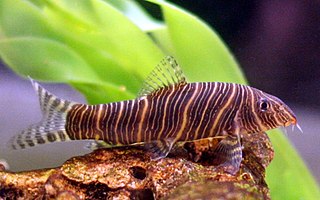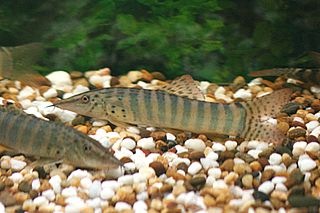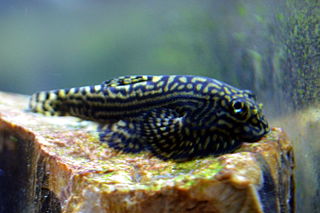
Cypriniformes is an order of ray-finned fish, which includes many families and genera of cyprinid fish, such as barbs, gobies, loaches, botias, and minnows. Cypriniformes is an "order-within-an-order", placed under the superorder Ostariophysi—which is also made up of cyprinid, ostariophysin fishes. The order contains 11–12 families, over 400 genera, and more than 4,250 named species; new species are regularly described, and new genera are recognized frequently. Cyprinids are most diverse in South and Southeast Asia, but are entirely absent from Australia and South America. At 112 years old, the longest-lived cypriniform fish documented is the bigmouth buffalo.

Cobitidae, also known as the true loaches, is a family of Old World freshwater fish. They occur throughout Eurasia and in Morocco, and inhabit riverine ecosystems. Today, most "loaches" are placed in other families. The family includes about 260 described species. New species are being described regularly.

Balitoridae, the hillstream loaches or river loaches, is a family, of small fish from South, Southeast and East Asia. The family includes about 202 species. They are sometimes sold as "lizardfish" or "flossensaugers". Many of the species are popular for aquaria, species in the genus Sewellia are most commonly sold in the aquaria trade. They have a number of similarities with the Cobitidae, their sibling family of "loaches", such as multiple barbels around the mouth. They should not be confused with the loricariids, which look similar but are a family of catfish.

The clown loach, or tiger botia, is a tropical freshwater fish belonging to the botiid loach family. It is the sole member of the genus Chromobotia. It originates in inland waters in Indonesia on the islands of Sumatra and Borneo. In Sentarum, West Borneo that fish named: ulanguli. It is a popular fish in the freshwater aquarium trade and is sold worldwide.

Botia is a genus of freshwater fish in the loach family (Botiidae). It was a large genus with about 20 species. In 2004 Maurice Kottelat proposed in his paper to divide the genus into four related genera based on fish appearance and locality:

The pond loach, also known as the Dojo loach, oriental weatherloach or oriental weatherfish, is a freshwater fish in the loach family Cobitidae. They are native to East Asia, but are also popular as an aquarium fish and introduced elsewhere in Asia and to Europe, America and Australia. The alternate name weather loach is shared with several other Cobitidae, including the other members of the genus Misgurnus and the spotted weather loach. This term comes from their ability to detect changes in barometric pressure before a storm and react with frantic swimming or standing on end.
Maurice Kottelat is a Swiss ichthyologist specializing in Eurasian freshwater fishes.

Botiidae, the pointface loaches, is a family of cypriniform ray-finned fishes from South, Southeast, and East Asia. Until recently they were placed in the true loach family Cobitidae, until Maurice Kottelat revised the loaches and re-elevated this taxon to family rank in 2012. The family includes about 56 species.
The true Kuhli loach, which can be used synonymously with "coolie" loach, occasionally referred to as eel loach, is a small eel-like freshwater fish belonging to the loach family (Cobitidae). They originate from the island of Java in Indonesia. This serpentine, worm-shaped creature is very slender and nocturnal. Its distinctive orange-pink coloration with triangular black stripes and long lifespan makes it a popular aquarium species.

Loaches are ray-finned fish of the suborder Cobitoidei. They are freshwater, benthic (bottom-dwelling) fish found in rivers and creeks throughout Eurasia and northern Africa. Loaches are among the most diverse groups of fish; the 1249 known species of Cobitoidei comprise about 107 genera divided among 9 families.
Parasewellia is a small genus of hillstream loaches endemic to Vietnam. Described in a single work by Nguyen & Nguyen, the validity of claims, as of 2012, cannot be properly analyzed due to poor descriptions and low quality of illustrations. Due to extremely restricted ranges it is possible that multiple claimed species represent a single one. Maurice Kottelat places them under Sewellia.

Sewellia is a genus of fish in the family Gastromyzontidae. They are commonly called hillstream loaches and are found in Laos and Vietnam. According to Roberts (1998) a possible defining characteristic of the genus Sewellia is their posterior pelvic valve is highly complex and different from other rheophilic loaches, their posterior pelvic valve involves the overlapping of the second to last ventrally exposed rays. Adapted to high velocity streams, Sewellia have depressed body shapes that are laterally expanded, thus increasing their hydrodynamical properties and allowing them to better stay attached to rocks in swift current. Sewellia also have paired fins with a single simple ray and numerous branched rays allowing them to grip rocks in swift current.

The Gastromyzontidae are a family of loaches native to China and Southeast Asia, where typically found in streams and rivers with a fast current. The family includes about 137 species in eighteen genera. This family was resurrected by M. Kottelat in his review and revision of the loaches in 2012. They are commonly called hillstream loaches.
Sewellia speciosa is a species of fish that is part of the family Gastromyzontidae. The fish in both Laos and Vietnam. The fish reaches up to 5.4 centimeters long. (SL)
Sewellia breviventralis is a species of fish belonging in the family Gastromyzontidae. The fish is only known in Vietnam and reaches up to 5.1 cm (2.0 in) long (SL).
Sewellia diardi is a species of fish belonging in the Gastromyzontidae family. The fish is found in Laos, the fish is 7.2 cm (2.8 in) long (SL).
Sewellia elongata is a species of fish in the genus Sewellia. The fish is found in the Se Kong River and is 7.3 cm (2.9 in) long (SL).
Sewellia pterolineata is a species of fish in the genus Sewellia. The fish is found in the Trac Khuc River and is 4.4 cm (1.7 in) long (SL).
Sewellia patella is a species of fish belonging to the Gastromyzontidae family. The fish is found in Vietnam and the maximum length for the fish is 4.8 cm (1.9 in) long (SL).
Sewellia media is a species of fish in the family Gastromyzontidae. The fish is only known in Vietnam.









